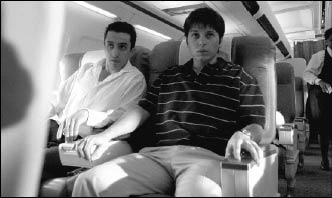Next story: The Books
Eyes Wide Shut: United 93, Hard Candy
by M. Faust
What are you willing to look at when you go to the theater to see a movie?
Whether it’s because of my age or the times we live in, I find a real element of risk in going to the movies. There are things that I do not wish to see, images and actions I would rather not chance having burned into my brain in that singular and powerful way that movies are able to do.
In a purely free market, people would be able to see whatever they wanted to see, just as they would be allowed to provide whatever images other people were willing to buy. We, of course, have no such system—thank god—but it certainly seems to be moving there. If even the most liberal parents knew what was going on in a lot of video porn, which is now so mainstream that it is advertised and even reviewed on radio stations and magazines that cater to young audiences, they would be appalled.
Even closer to the mainstream, it is now de rigeur for horror films to feature scenes of grueling torture, in which the pain of the victim is emphasized. That used to be a taboo, simply as a matter of public taste. Now, it’s what teens expect to see when they go to a horror film (unrestricted by the MPAA, which regularly gives such films an R rating rather than the NC-17 they ought to have).
These thoughts apply in one way to the quasi-horror film Hard Candy, about the revenge taken by a 14-year-old girl on a 32-year-old man she accuses of being a pedophile. But they apply in a much different way to United 93, a film that will be seen by many more people. Polls indicate that a large number of people plan not to see this film, which concerns the events of September 11, 2001; I suspect that a lot of people will, and that it will pick up larger audiences in coming weeks as word gets around.

The fact that there are no movie star names in the advertising for United 93 may lead you to believe that this is a schlock movie made to capitalize on morbid interest in a national tragedy. Were that the case, it would be easy to dismiss. But Airport 9/11 it is not; it was made by Paul Greengrass, a British filmmaker who cut his teeth in documentaries. He’s best known in the US for The Bourne Supremacy, but his real calling card is the 2002 docudrama Bloody Sunday, which recreated with unforgettable intensity the 1972 Irish civil-rights march in which unarmed civilians were fired on by British troops.
Before anything else, it must be said that United 93 is an exceedingly well-made film. Although it focuses on the events about the titular plane, the one that did not reach its target, fully half of its running time is devoted to recreating that morning from the perspective of the airline and government agencies that watched it unfold, at first on radar screens, later on CNN. The authenticity of these scenes is helped by the fact that Greengrass cast many of these people as themselves, including Ben Sliney, national operations manager of the FAA (that is to say, the man who had the power to shut down the nation’s airports, as he did later that morning). (If that seems somewhat improper for a public official, it should be noted that Sliney originally was hired as a technical advisor, and agreed to play himself only during production. I didn’t realize who he was while watching the film, and marveled at what an authoritative performance this unknown actor was giving.)
Greengrass similarly cast mostly unknown actors to play the crew and passengers of United 93, chosen for their similarity to the people they are playing. (Scanning the credits afterward, there are a few names I recognized from TV sitcoms, but they disappeared into their parts to the extent that with one exception I don’t recall them in the film.)
No one knows for sure what happened on United 93. We know that the passengers were aware of what was happening and planned to try to prevent it; we know that the plane went down in a field in Pennsylvania rather than crashing into its target, the White House.
Can you think about what happened on that plane for more than a moment without getting a lump in your throat? Of course not. Focusing on September 11 from this vantage point may strike some as unduly sadistic, but it’s the only possible way to do it. Any other approach would be too grim to bear; at least in this one area, the enemy was engaged and bested. (And while it doesn’t dwell on it, the film does make the point that in bringing down United 93 a group of ordinary Americans did what the military failed to do that morning.)
Having begun this project, Greengrass proceeded with admirable restraint. There are a dozen places where the film pulls back rather than go for a sure-fire Big Moment. We know that we will hear the words “Let’s roll,” but it’s minimized. People are attacked and killed on the plane, passengers early on, a terrorist or two later—surmise on the film’s part—but they are not dwelt on or gloated over.
In what you know in advance will be the most unbearable moment, we listen to some of the passengers speaking to their loved ones on the phone. These scenes could have been much worse than they are.
And those scenes are precisely the ones that make me ask, why would we see this film? Why would anyone ask us to, and why would we want to? You probably won’t learn anything from it, aside from a stray detail or two. Greengrass is largely careful not to make large pronouncements about everything that happened (and didn’t happen) that day, but the inevitable truth is that when many of us see a film on a real subject, we adopt it as reality—we unconsciously perceive that we “know” those events, not always accepting that they have been predigested for us, no matter how carefully the filmmakers strive for objectivity.
In the film’s press notes, Greengrass says that the passengers on United 93 faced two choices: “Do we sit here and do nothing and hope for the best, hope it turns out all right? Or do we do something about it? And if so, what can we do? That group of people weighed those choices, made a decision and acted upon it. And I think that if we look at what happened, we find a story of immense courage and fortitude—those people were very, very brave.”
No question. But it was also crystal clear to them what was about to happen. Although the film offers them a glimmer of hope for survival, they are choosing between certain death and death with meaning. But important choices are not always made with such overwhelming information. People in a position to make decisions have been known to do so with faulty facts. Does the fact that they struck out boldly validate their actions? No, just the opposite. “Action” like that got us into Iraq; god forbid it get us into Iran as well. I may be overreading Greengrass’s remarks, sniffing propaganda where none exists. Still, if you decide to see this film, it’s something to keep in mind.

There’s rather less ambiguity to be found in Hard Candy, a cat-and-mouse game in which the mice turn out to be us. Despite some ostentatious attempts to render the material cinematic by firsttime director David Slade, this is essentially a filmed stage play, and a talky one at that, involving two characters. Jeff (Patrick Wilson) is a 32-year-old photographer who is first seen having an Internet conversation with a correspondent who calls herself “Thonggrrrrrl14,” the number being her age. They arrange a meeting at a coffee shop, and go back to his house. This may be a case of a pedophile stalking a victim, even if, as soon becomes clear, young Hayley (Ellen Page) is neither so innocent nor helpless as she looks. A precocious reader of Zadie Smith novels and surgical manuals, she has determined that Jeff is guilty of a particularly heinous crime and has set herself up as an avenger.
It’s disturbing that the people most likely to buy a ticket for this film are the ones who know her plan and want to see the film because of it. It also makes it somewhat counterproductive for me not to give that crucial plot element away, as those of you who don’t know about it might appreciate the warning. Still, the movie critic code of ethics requires my silence. I will say only that while we actually see nothing horrifying, its off-camera depiction is all the more sickening for the way the film protracts it. (Once again, I would like to know what the hell the MPAA people were thinking when they gave this an R rating.) The script by playwright Brian Nelson wants to keep us guessing as to who is the true criminal and who the true victim, but he dances around the issue so much that in the end we’re simply praying for an earthquake to take both of them away.
|
Issue Navigation> Issue Index > v5n17: Power Failure (4/27/06) > Film Reviews > Eyes Wide Shut: United 93, Hard Candy This Week's Issue • Artvoice Daily • Artvoice TV • Events Calendar • Classifieds |









 Current Issue
Current Issue